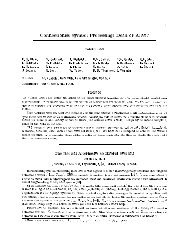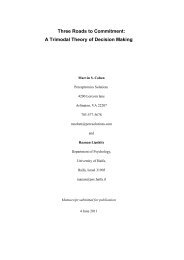Three Roads to Commitment: A Trimodal Theory of Decision Making
Three Roads to Commitment: A Trimodal Theory of Decision Making
Three Roads to Commitment: A Trimodal Theory of Decision Making
You also want an ePaper? Increase the reach of your titles
YUMPU automatically turns print PDFs into web optimized ePapers that Google loves.
<strong>Three</strong> <strong>Roads</strong> <strong>to</strong> <strong>Commitment</strong>: A <strong>Trimodal</strong> <strong>Theory</strong> <strong>of</strong> <strong>Decision</strong> <strong>Making</strong> 9<br />
commitments are a baseline that can be strengthened or added <strong>to</strong>. Matching prompts the implicit question, What<br />
should a person in my role do in a situation <strong>of</strong> this kind (cf. March, 1993, p. 58). The answers are provided by<br />
Warrants, or rules (we will call them practices), whose conditions are found <strong>to</strong> match the situation and decision<br />
maker role, and whose actions may then be executed or adopted as intentions. Practices are themselves intentions<br />
that are general across situations and persistent in temporal scope. 3 They reflect pre-existing social norms<br />
(Bicchieri, 2005; Bicchieri, Jeffrey, & Skyrms, 2009), organizational routines (Levitt & March, 1988), standard<br />
operating procedures and best practices (Betsch & Haberstroh, 2004), expert solution patterns in disciplines like<br />
medicine or chess (Chase & Simon, 1973), patterns recognized by pr<strong>of</strong>icient decision makers (Klein, 1993), scripts<br />
for familiar behavior (Shank & Abelson, 1977, 1995), previous cases and precedents (Schank, 1990, 1999;<br />
Kolodner, 1993), argumentation schemes (Wal<strong>to</strong>n,1996), principles and strategies for conversation (Grice, 1989;<br />
Sperber & Wilson, 1995; Sacks, 1995), heuristics (Gigerenzer et al., 1999; Simon & Newell, 1958), competitive or<br />
cooperative strategies in social enterprises (Axelrod, 1984), culturally modulated emotional dispositions such as<br />
anger, guilt, honor, and love (LeDoux, 1996), personal policies (Bratman, 1999; Beach, 1990), cultural maxims and<br />
themes (Lak<strong>of</strong>f, 1987), religious doctrine (Atran, 2002), shared intentions for joint activity (Gilbert, 1996), moral<br />
principles and political ideologies (Etzioni, 1988; Thompson, Ellis, & Waldavsky, 1990), or goal trajec<strong>to</strong>ries and<br />
high-level values (Beach, 1990). Practices are <strong>of</strong>ten associated with different social identities or roles that a single<br />
individual might take on, related <strong>to</strong> kin, work, pr<strong>of</strong>ession, voluntary association, religion, nationality, region,<br />
political ideology, or personal self-image (Etzioni, 1988, 2000).<br />
When a practice (i.e., a Warrant) is activated by a current or anticipated situation (Grounds), it focuses attention<br />
on the situation type and the agent’s role in it. However, matching is not merely a front end for choice. Multiple<br />
mutually exclusive options need not be, and most frequently are not, made directly available by a practice or rule.<br />
An action generated when the conditions <strong>of</strong> a practice match a situation and role can be committed <strong>to</strong> and<br />
implemented without stepping outside the practice <strong>to</strong> generate and compare other possibilities. In short, matching<br />
generates intentions and actions by processes other than choice. If the situation and role that match the practice are<br />
current, the practice can give rise <strong>to</strong> immediate action (the Claim). When the situation is anticipated, the practice<br />
3 Terms like schema, rule, or norm <strong>of</strong>ten fit just as well. We do not, however, equate intentions with internal or<br />
external representations <strong>of</strong> the intended action (although such representations <strong>of</strong>ten do play a role in planning).<br />
Intentions exist as an interconnected set <strong>of</strong> dispositions ((a) through (e) above) – even if they are merely implicit in<br />
neural network connections and facts about the situation (Hutchins, 1995).




